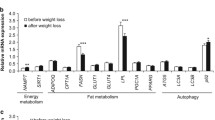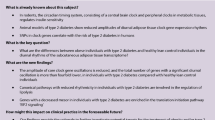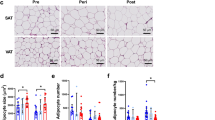Abstract
Menopausal women exhibit a loss of circadian coordination, a process that runs parallel with a redistribution of adipose tissue. However, the specific genetic mechanisms underlying these alterations have not been studied. Thus, the aim of the present study was to determine whether the development of menopause induces an alteration of the genes that control biological rhythms in human subcutaneous (SAT) and visceral (VAT) adipose tissue, and whether changes in clock gene expression are involved in the increased risk of developing metabolic syndrome (MetS), which is frequently associated with menopause. To this end, VAT and SAT biopsies were taken in pre- (n = 7) and postmenopausal (n = 7) women at similar hours in the morning. RNA was extracted, and a microarray analysis was made. Data were confirmed by quantitative real-time polymerase chain reaction. Western blot and immunohistochemical analysis were also performed. When clock gene expression was compared between both groups of women, data in SAT showed that expression of the core clock gene period3 was significantly higher in postmenopausal women, while casein kinase-1δ, E1A-binding protein and cAMP-responsive element were preferentially expressed in the premenopausal group. In VAT, period2 (PER2) and v-myc myelocytomatosis viral oncogene expressions were significantly higher in the postmenopausal group. Western blot analysis indicated that PER2 and PER3 protein expression was also increased in postmenopausal women. In addition, several genes, including PER2, were differentially expressed depending on whether or not the patient met the MetS criteria. We conclude that menopause transition induces several changes in the genotype of the adipose tissue chronobiological machinery related to an increased risk of developing MetS.



Similar content being viewed by others
References
Alberti KG, Zimmet P, Shaw J (2006) Metabolic syndrome—a new world-wide definition. A consensus statement from the International Diabetes Federation. Diabet Med 23:469–480
Bhandari DR, Seo KW, Jung JW, Kim HS, Yang SR, Kang SK, Kang KS (2011) The regulatory role of c-MYC on HDAC2 and PcG expression in human multipotent stem cells. J Cell Mol Med 15(7):1603–1614
Carpen JD, Archer SN, Skene DJ, Smits M, von Schantz M (2005) A single-nucleotide polymorphism in the 5'-untranslated region of the hPER2 gene is associated with diurnal preference. J Sleep Res 14:293–297
Cermakian N, Boivin DB (2009) The regulation of central and peripheral circadian clocks in humans. Obes Rev 10(Suppl 2):25–36
Chedraui P, Perez-Lopez FR, Mendoza M, Leimberg ML, Martínez MA, Vallarino V, Hidalgo L (2010) Factors related to increased daytime sleepiness during the menopausal transition as evaluated by the Epworth sleepiness scale. Maturitas 65:75–80
Dijk DJ, Archer SN (2010) PERIOD3, circadian phenotypes, and sleep homeostasis. Sleep Med Rev 14:151–160
Englund A, Kovanen L, Saarikoski ST, Haukka J, Reunanen A, Aromaa A, Lönnqvist J, Partonen T (2009) NPAS2 and PER2 are linked to risk factors of the metabolic syndrome. J Circadian Rhythms 7:5
Garaulet M, Madrid JA (2009) Chronobiology, genetics and metabolic syndrome. Curr Opin Lipidol 20:127–134
Garaulet M, Lee YC, Shen J, Parnell LD, Arnett DK, Tsai MY, Lai CQ, Ordovas JM (2009) CLOCK genetic variation and metabolic syndrome risk: modulation by monounsaturated fatty acids. Am J Clin Nutr 90:1466–1475
Garaulet M, Ordovas JM, Gomez-Abellan P, Martinez JA, Madrid JA (2010a) An approximation to the temporal order in endogenous circadian rhythms of genes implicated in human adipose tissue metabolism. J Cell Physiol 226:2075–2080
Garaulet M, Corbalan MD, Madrid JA, Morales E, Baraza JC, Lee YC, Ordovas JM (2010b) CLOCK gene is implicated in weight reduction in obese patients participating in a dietary programme based on the Mediterranean diet. Int J Obes (Lond) 34:516–523
Garaulet M, Corbalán-Tutau MD, Madrid JA, Baraza JC, Parnell LD, Lee YC, Ordovas JM (2010c) PERIOD2 variants are associated with abdominal obesity, psycho-behavioral factors, and attrition in the dietary treatment of obesity. J Am Diet Assoc 110(6):917–921
Gene Ontology Consortium (2008) The gene ontology project in 2008. Nucleic Acid Res 36:D440–D444
Ghanayem BI, Bai R, Kissling GE, Travlos G, Hoffler U (2010) Diet-induced obesity in male mice is associated with reduced fertility and potentiation of acrylamide-induced reproductive toxicity. Biol Reprod 82:96–104
Gibson EM, Williams WP 3rd, Kriegsfeld LJ (2009) Aging in the circadian system: considerations for health, disease prevention and longevity. Exp Gerontol 44:51–56
Gomez-Abellan P, Hernandez-Morante JJ, Lujan JA, Madrid JA, Garaulet M (2008) Clock genes are implicated in the human metabolic syndrome. Int J Obes (Lond) 32:121–128
Gomez-Santos C, Hernandez-Morante JJ, Margareto J, Larrarte E, Formiguera X, Martínez CM, Garaulet M (2011) Profile of adipose tissue gene expression in premenopausal and postmenopausal women: site-specific differences. Menopause 18:675–684
Green CB, Takahashi JS, Bass J (2008) The meter of metabolism. Cell 134:728–742
Hamet P, Tremblay J (2006) Genetics of the sleep–wake cycle and its disorders. Metabolism 55(Suppl 2):S7–S12
Holvoet P (2008) Relations between metabolic syndrome, oxidative stress and inflammation and cardiovascular disease. Verh K Acad Geneeskd Belg 70:193–219
Loboda A, Kraft WK, Fine B, Joseph J, Nebozhyn M, Zhang C, He Y, Yang X, Wright C, Morris M, Chalikonda I, Ferguson M, Emilsson V, Leonardson A, Lamb J, Dai H, Schadt E, Greenberg HE, Lum P (2009) Diurnal variation of the human adipose transcriptome and the link to metabolic disease. BMC Med Genomics 2:7
Marrades MP, Milagro FI, Martinez JA, Moreno-Aliaga MJ (2006) Differential expression of aquaporin 7 in adipose tissue of lean and obese high fat consumers. Biochem Biophys Res Comm 339:785–789
Otway DT, Mäntele S, Bretschneider S, Wright J, Trayhurn P, Skene DJ, Robertson MD, Johnston JD (2011) Rhythmic diurnal gene expression in human adipose tissue from individuals who are lean, overweight, and type 2 diabetic. Diabetes 60:1577–1581
Partonen T, Treutlein J, Alpman A, Frank J, Johansson C, Depner M, Aron L, Rietschel M, Wellek S, Soronen P, Paunio T, Koch A, Chen P, Lathrop M, Adolfsson R, Persson ML, Kasper S, Schalling M, Peltonen L, Schumann G (2007) Three circadian clock genes Per2, Arntl, and Npas2 contribute to winter depression. Ann Med 39:229–238
Reilly DF, Curtis AM, Cheng Y, Westgate EJ, Rudic RD, Paschos G, Morris J, Ouyang M, Thomas SA, FitzGerald GA (2008) Peripheral circadian clock rhythmicity is retained in the absence of adrenergic signaling. Arterioscler Thromb Vasc Biol 28:121–126
Ritchie JD, Miller CK, Smiciklas-Wright H (2005) Tanita foot-to-foot bioelectrical impedance analysis system validated in older adults. J Am Diet Assoc 105:1617–1619
Tchernof A, Poehlman ET, Despres JP (2000) Body fat distribution, the menopause transition, and hormone replacement therapy. Diabetes Metab 26:12–20
Toth MJ, Tchernof A, Sites CK, Poehlman ET (2000) Menopause-related changes in body fat distribution. Ann N Y Acad Sci 904:502–506
Turek FW, Joshu C, Kohsaka A, Lin E, Ivanova G, McDearmon E, Laposky A, Losee-Olson S, Easton A, Jensen DR, Eckel RH, Takahashi JS, Bass J (2005) Obesity and metabolic syndrome in circadian Clock mutant mice. Science 308:1043–1045
Um JH, Yang S, Yamazaki S, Kang H, Viollet B, Foretz M, Chung JH (2007) Activation of 5'-AMP-activated kinase with diabetes drug metformin induces casein kinase Iepsilon (CKIepsilon)-dependent degradation of clock protein mPer2. J Biol Chem 282:20794–20798
Walters JF, Hampton SM, Ferns GA, Skene DJ (2005) Effect of menopause on melatonin and alertness rhythms investigated in constant routine conditions. Chronobiol Int 22:859–872
Walters JF, Hampton SM, Deanfield JE, Donald AE, Skene DJ, Ferns GA (2006) Circadian variation in endothelial function is attenuated in postmenopausal women. Maturitas 54:294–303
Zvonic S, Ptitsyn AA, Conrad SA, Scott LK, Floyd ZE, Kilroy G, Wu X, Goh BC, Mynatt RL, Gimble JM (2006) Characterisation of peripheral circadian clocks in adipose tissues. Diabetes 55:962–970
Author information
Authors and Affiliations
Corresponding author
Electronic supplementary material
Below is the link to the electronic supplementary material.
Supplementary table 1
Subcutaneous adipose tissue relative mRNA expression (arbitrary units) of all the clock-related genes analyzed in the present study. (DOCX 19 kb)
Supplementary table 2
Visceral adipose tissue relative mRNA expression (arbitrary units) of all the clock-related genes analyzed in the present study. (DOCX 19 kb)
Supplementary table 3
Variations in visceral and subcutaneous adipose tissue expression level of the different genes selected for microarray data validation (by mean of the real-time quantitative PCR method) between pre- and postmenopausal women. (DOCX 19 kb)
Supplementary Figure 1
Images derived from the inmunocytochemical analysis (x200) for both adipose tissue depots (subcutaneous and visceral) and both menopausal status (PRE and POST-menopausal women) to detect the presence of T-lymphocytes (stained with anti-CD3 antibodies). An image derived from sections of frozen human thymus (positive control)(x200) is included. (JPEG 1338 kb)
Supplementary Figure 2
Images derived from the inmunocytochemical analysis (x200) for both adipose tissue depots (subcutaneous and visceral) and both menopausal status (PRE and POST-menopausal women) to detect the presence of macrophages (stained with anti-CD14 antibodies). The arrows indicate the existence of a macrophage. (JPEG 982 kb)
About this article
Cite this article
Hernandez-Morante, J.J., Gomez-Santos, C., Margareto, J. et al. Influence of menopause on adipose tissue clock gene genotype and its relationship with metabolic syndrome in morbidly obese women. AGE 34, 1369–1380 (2012). https://doi.org/10.1007/s11357-011-9309-2
Received:
Accepted:
Published:
Issue Date:
DOI: https://doi.org/10.1007/s11357-011-9309-2




